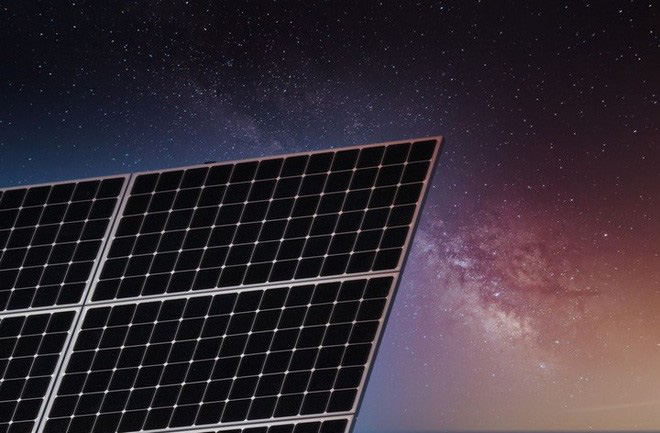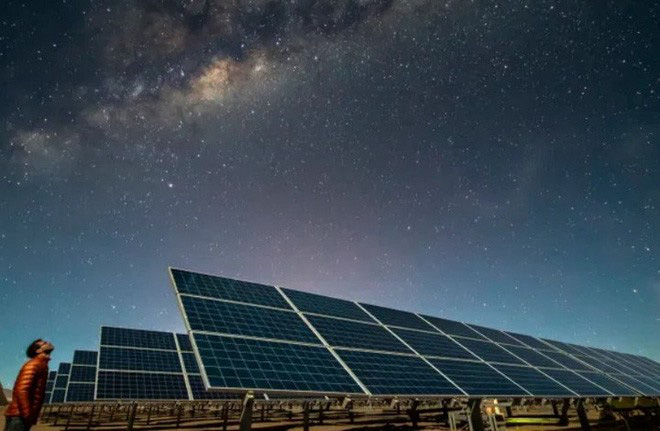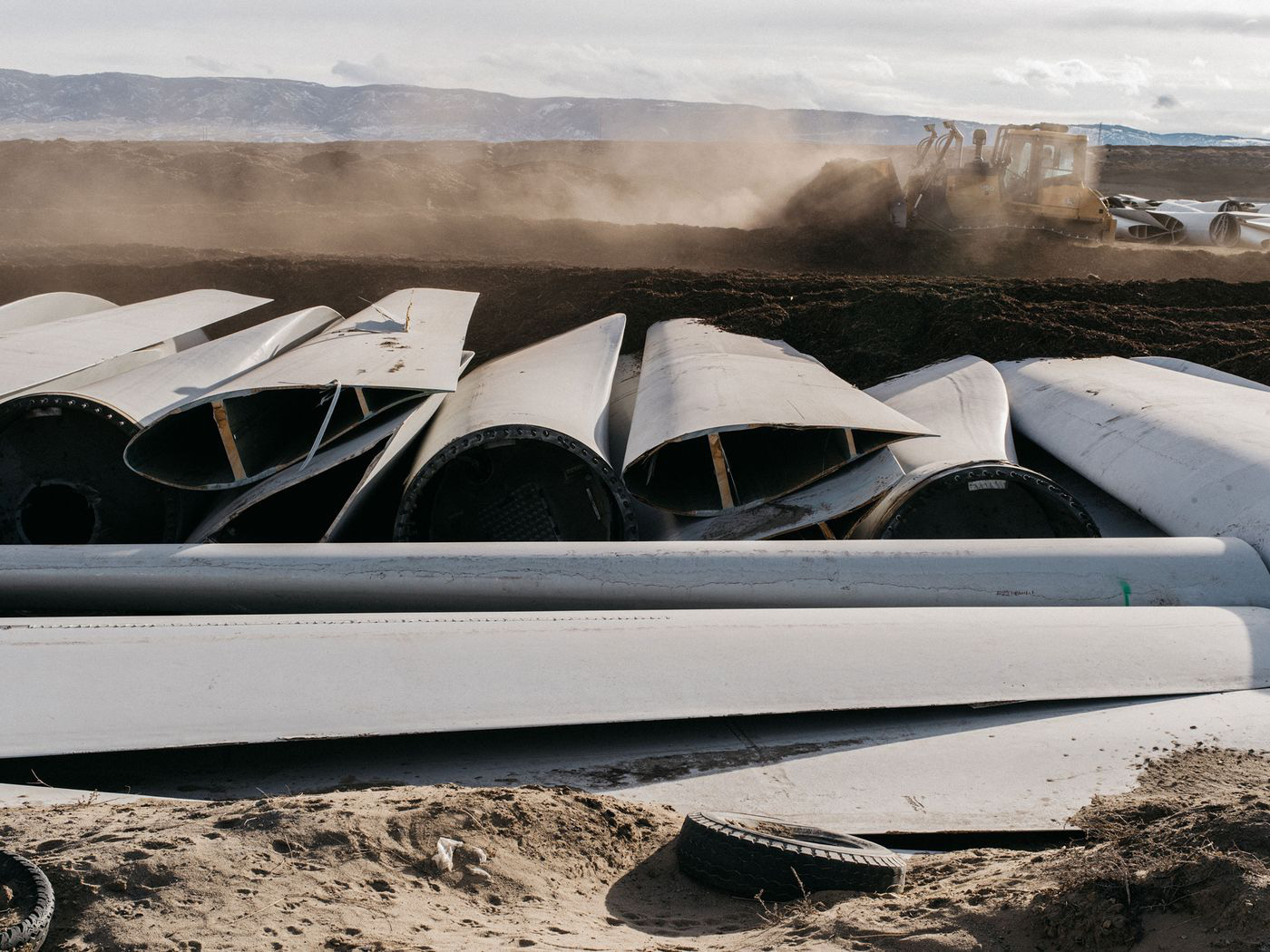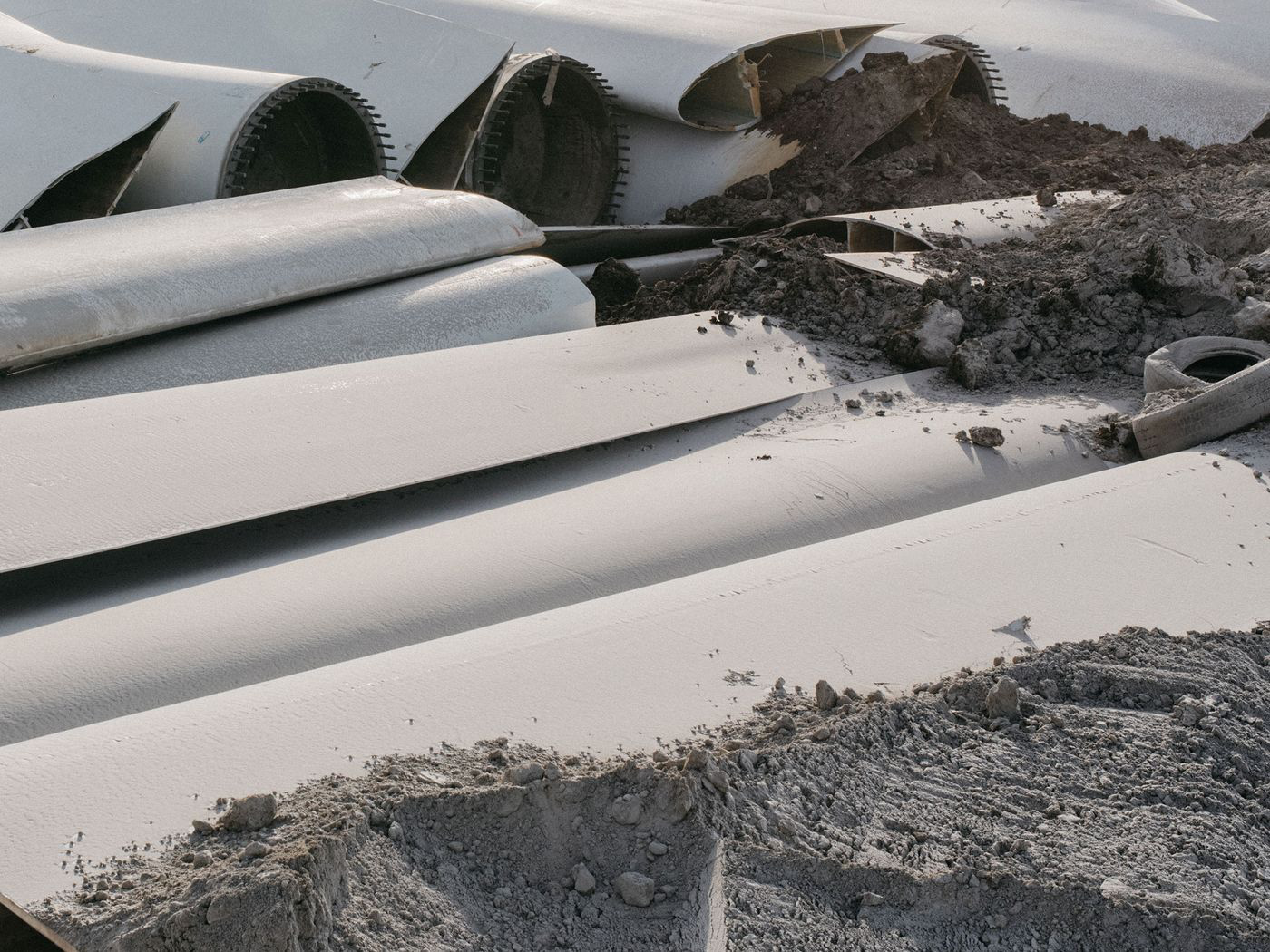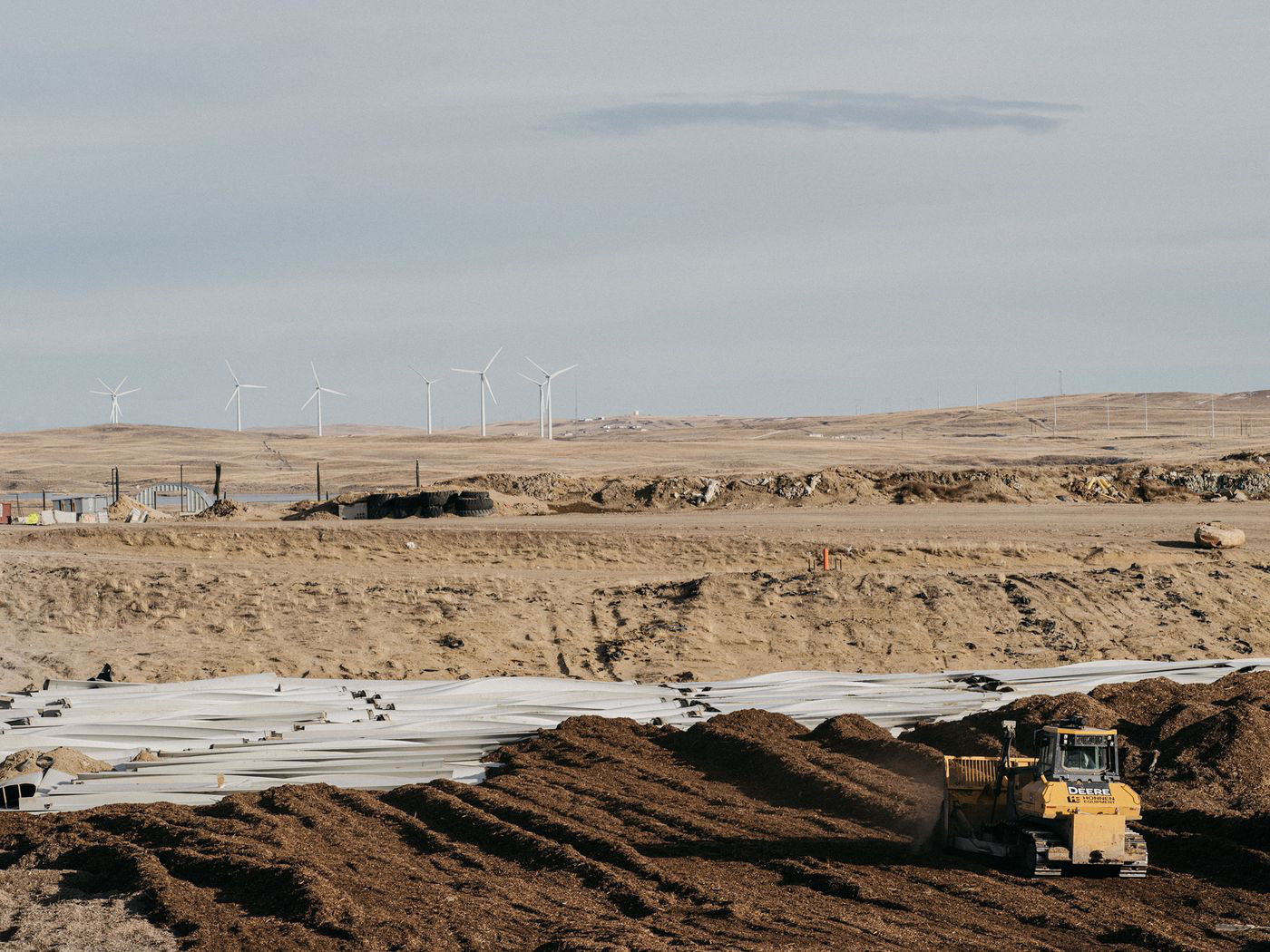Thứ Bảy, tháng 2 29, 2020
Thứ Sáu, tháng 2 28, 2020
Wind plus storage critical for renewable energy transition

A new report from Navigant Research shows that despite the limited number of combined wind plus storage projects, the pairing of these technologies is critical to achieving a greater reliance on renewable energy generation.
The rise of combined solar plus storage projects is reshaping the energy storage industry, yet employing energy storage for wind integration has fallen far behind.
“The links between wind and energy storage projects remain far less established than storage for solar PV as a result of both technical and economic factors,” says Alex Eller, senior research analyst at Navigant Research. “Although combined wind plus storage projects offer similar benefits and potential, little development has taken place thus far for these combined projects.”
Read more
Queensland approves Australia’s largest wind farm
Pivot Power places order with Wärtsilä for 100 MW of energy storage
Queensland approves Australia’s largest wind farm
Pivot Power places order with Wärtsilä for 100 MW of energy storage
In order to launch more successful projects, the report recommends wind and energy storage operators invest in robust software to effectively pair the technologies with accurate wind output forecasts and market pricing.
Stakeholders will also need to explore new revenue streams to address reductions or outright eliminations of subsidies for wind plants, as well as maximize the use of existing transmission networks. Additionally, wind farm developers should partner early with leading storage providers to identify cost-effective sites for potential projects and viable revenue streams.
The report, Optimizing Wind Power Plants with Energy Storage, aims to provide an in-depth look at the drivers and challenges for this growing market.
Specific attention is paid to the applications of energy storage for wind integration, existing and upcoming projects, the competitive landscape, and how this market is expected to grow over the next decade.
Thứ Tư, tháng 2 26, 2020
Công suất các nhà máy điện than sẽ giảm còn 8.760 MW vào năm 2025

Đến năm 2025, nguồn nhiệt điện than chiếm khoảng 37,1% tổng công suất lắp đặt nguồn điện, giảm 13% so với Quy hoạch điện VII điều chỉnh.
Ảnh minh họa. (Nguồn: TTXVN)
Ban Chỉ đạo Quốc gia về phát triển điện lực cho biết, so với Quy hoạch điện VII điều chỉnh, trong cơ cấu nguồn điện mới có công suất nhiệt điện than sẽ giảm 8.760 MW vào năm 2025 và giảm 6.340 MW vào năm 2030, chủ yếu do các dự án chậm tiến độ và một số địa phương không đồng thuận phát triển nhiệt điện than.
Như vậy, năm 2020, nguồn nhiệt điện than sẽ chiếm khoảng 33,2% tổng công suất lắp đặt nguồn điện, giảm gần 6.000 MW so với Quy hoạch điện VII điều chỉnh; nhiệt điện khí, dầu chiếm 14,8%, không thay đổi so với Quy hoạch điện VII điều chỉnh; thủy điện chiếm 30,1%, thủy điện nhỏ và năng lượng tái tạo chiếm 20,3%, cao hơn Quy hoạch điện VII điều chỉnh 10,3%. Tổng điện năng của điện gió và điện mặt trời đến năm 2020 đạt 12 tỷ kWh, vượt Chiến lược phát triển năng lượng tái tạo khoảng 3 lần.
Đến năm 2025, nguồn nhiệt điện than chiếm khoảng 37,1% tổng công suất lắp đặt nguồn điện, giảm 13% so với Quy hoạch điện VII điều chỉnh; nhiệt điện khí chiếm 13,7%, không thay đổi so với Quy hoạch điện VII điều chỉnh; thủy điện chiếm 18,2%, thủy điện nhỏ và năng lượng tái tạo chiếm 25,5%, cao hơn Quy hoạch điện VII điều chỉnh gần 13%.
Tổng sản lượng của điện gió và điện mặt trời đến năm 2025 sẽ đạt 36 tỷ kWh, vượt Chiến lược phát triển năng lượng tái tạo khoảng 2,6 lần.
Sang năm 2030, nguồn nhiệt điện than chiếm khoảng 33,6% tổng công suất lắp đặt nguồn điện, giảm 9% so với Quy hoạch điện VII điều chỉnh; nhiệt điện khí chiếm 19%, tăng 4% so với Quy hoạch điện VII điều chỉnh; thủy điện chiếm 13%; thủy điện nhỏ và năng lượng tái tạo chiếm 27%, cao hơn Quy hoạch điện VII điều chỉnh 6%.
Về cơ cấu điện năng, nhiệt điện than chiếm 42%, thấp hơn Quy hoạch điện VII điều chỉnh 11%; nhiệt điện khí chiếm 27,5%, tăng 10% so với Quy hoạch điện VII điều chỉnh; thủy điện chiếm 12,5%; thủy điện nhỏ và năng lượng tái tạo chiếm 14%, cao hơn Quy hoạch điện VII điều chỉnh 4%; nhập khẩu điện 4% , tăng 3% so với Quy hoạch điện VII điều chỉnh.
Tổng sản lượng của điện gió và điện mặt trời đến năm 2030 đạt 55 tỷ kWh, vượt Chiến lược phát triển năng lượng tái tạo 4 tỷ kWh.
Đến năm 2030, công suất của các nhà máy điện sử dụng khí LNG là 12.750 MW (không tính các nhà máy cũ chuyển sang sử dụng khí LNG); trong đó 6.000 MW đã được quy hoạch trong Quy hoạch điện VII điều chỉnh gồm các nhà máy điện: Nhơn Trạch 3 và 4 (công suất 1.500 MW); Sơn Mỹ I và II (4.500 MW).
Trong tính toán này, theo Ban Chỉ đạo, Nhà máy điện Kiên Giang (1.500 MW) - trong Quy hoạch điện VII điều chỉnh được quy hoạch sử dụng khí lô B phải chuyển sang sử dụng khí LNG. Theo số liệu cập nhật của Bộ Công Thương, khí lô B chỉ đủ cung cấp cho Trung tâm điện lực (TTĐL) Ô Môn nên nhà máy điện Kiên Giang, nếu xây dựng, thì phải chuyển đổi sang sử dụng khí LNG.
Theo Ban Chỉ đạo, địa điểm và phương án xây dựng nguồn cấp khí LNG cho nhà máy điện Kiên Giang không được đánh giá cao, nên cần thiết phải đánh giá, xem xét địa điểm khác thuận lợi hơn tại miền Nam để thay thế cho nhà máy này.
Như vậy, giai đoạn 2026-2030, tổng công suất các nhà máy điện sử dụng khí LNG cần bổ sung vào quy hoạch là 6.750 MW. Ngoài phát triển ở miền Nam, cần xem xét nghiên cứu phát triển các nhà máy điện sử dụng khí LNG khu vực miền Bắc để thay thế cho các nhà máy điện than Hải Phòng 3 và Vũng Áng 3.
Ngoài các nhà máy điện mới sử dụng LNG, các nhà máy điện hiện có thuộc TTĐL Phú Mỹ, Bà Rịa, Hiệp Phước, từ năm 2021 sẽ chuyển dần sang sử dụng khí LNG do nguồn khí Đông Nam Bộ cạn kiệt. Đến năm 2030, tổng công suất các nhà máy điện đang sử dụng khí Đông Nam Bộ phải chuyển đổi sang sử dụng LNG là khoảng 4.200 MW.
Tổng công suất nguồn điện mặt trời dự kiến phát triển đến năm 2025 là 14.450 MW, đến năm 2030 là 20.050 MW. Theo Ban Chỉ đạo, hiện tại đã bổ sung vào quy hoạch 10.300 MW công suất. Như vậy, giai đoạn 2021-2025 cần bổ sung khoảng 4.000 MW (tương ứng 5.000 MWp), giai đoạn 2026-2030 cần bổ sung thêm khoảng 5.600 MW (7.000 MWp).
Bên cạnh đó, tổng công suất nguồn điện gió dự kiến phát triển đến năm 2025 cũng là 6.030 MW, đến năm 2030 là 10.090 MW. Hiện tại đã bổ sung vào quy hoạch 4.800 MW, theo Ban Chỉ đạo, giai đoạn 2021-2025 cần bổ sung khoảng 1.200 MW, giai đoạn 2026-2030, bổ sung 4.000 MW.
Ban Chỉ đạo cũng cho biết, giai đoạn 2021-2025 cần bổ sung quy hoạch 2.500 MW điện nhập khẩu từ Lào, giai đoạn 2026-2030, bổ sung 2.400 MW cũng từ Lào.
Ngoài ra, để tích hợp khối lượng lớn nguồn điện gió và mặt trời trên, ngoài nhà máy thủy điện tích năng (1.200 MW) đã được quy hoạch, giai đoạn 2021-2025 cần bổ sung 1.200 MW pin tích năng, giai đoạn 2026-2030 cần bổ sung 3.000 MW pin tích năng tại miền Nam./.
Mai Phương (TTXVN/Vietnam+)
Thứ Bảy, tháng 2 15, 2020
New energy innovations to make the future brighter
1. An Australian company has been working on a system that uses underwater buoys to convert sea waves into zero-emission energy and desalinated water. 2. Scientists in China are producing solar panels that can produce energy from the last source you’d expect — rainwater. 3. A Japanese engineer has designed a new type of wind turbine that he believes would be able to harness power from typhoons. 4. Researchers at Binghamton University have come up with an interesting way to harness energy, using a resource we have far too much of — bacteria. 5. US scientists have developed a bionic leaf that can convert solar energy into liquid fuel.
Report: Offshore to power 25% of all wind demand by 2028

The possibility of offshore wind becoming cheaper than coal, gas and nuclear in most major countries is a question of when, rather than if, according to a new report by market research firm Wood Mackenzie.
With a diverse 314 GW global offshore wind portfolio to tap in to and cumulative offshore wind capacity expected to increase more than seven-fold by 2028, the industry is set for a strong decade ahead.
According to the figures in the report, offshore wind will constitute 25 percent of total wind demand in 2028 – up from 10 percent in 2019 – and will narrow the gap with offshore upstream oil and gas in terms of capital expenditure deployment.
Foresight 20/20: Onshore & Offshore Wind
Wood Mackenzie's Foresight 20/20 series offers analysis and predictions about the decade ahead. Fill in the form on this page to get our full analysis of onshore and offshore wind trends over the past decade and predictions for the 2020s.
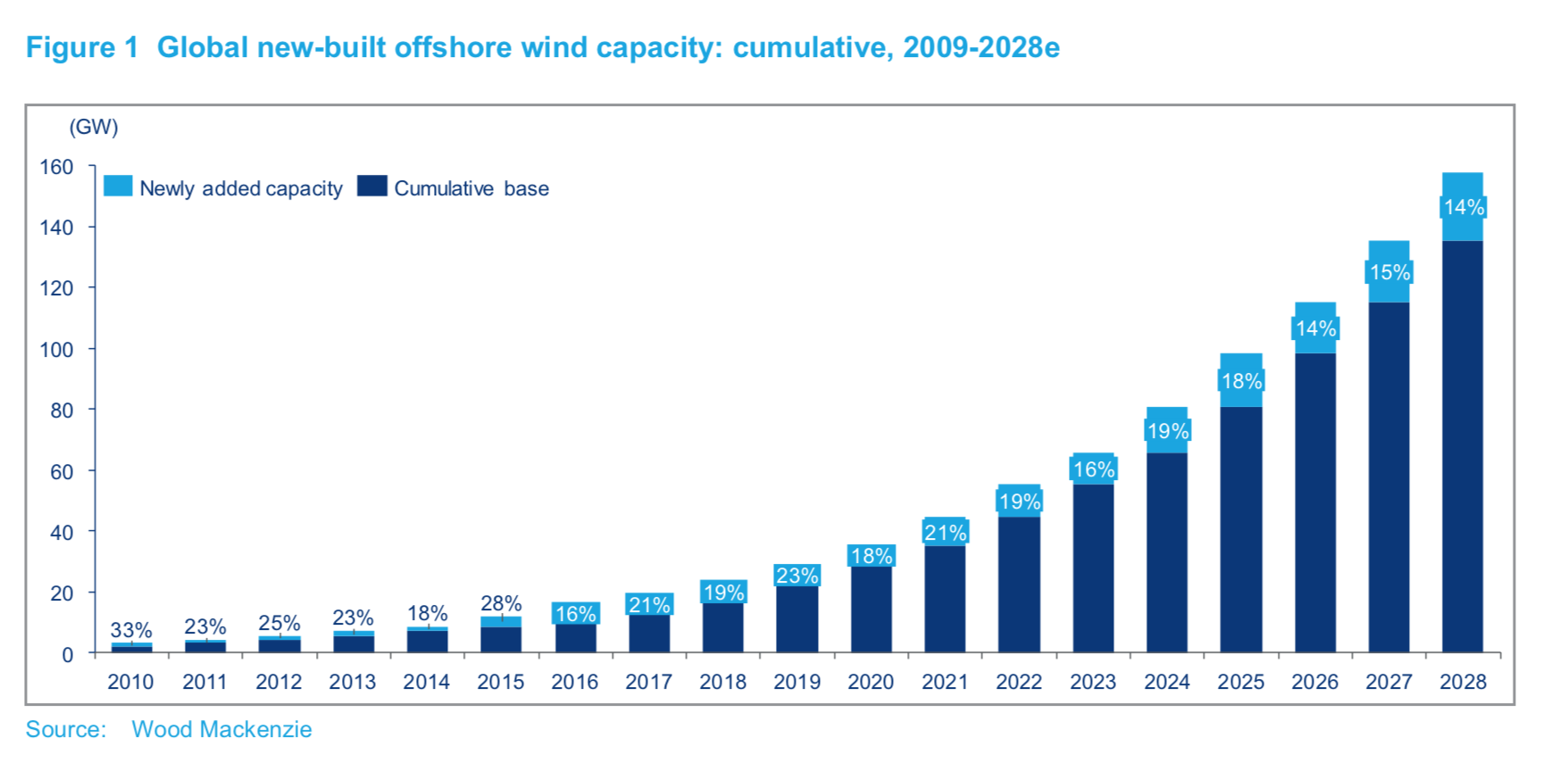
The Onshore Wind Foresight 2020 piece includes:
Defining a decade: A march towards mainstream as costs plummet and expand global adoption
Future focused: A final round of consolidation focuses innovation efforts and squeezes additional economies of scale
Growth gamechanger: Transmission investment is the key to changing the trajectory for onshore wind market growth
Gray swan risk: Repowering running into recycling issues
The Offshore Wind Foresight 2020 piece includes:
Defining a decade: From niche to ‘hard to ignore’
Future focused: Offshore wind is on track to become a mainstream source of electricity
Growth gamechanger: Floating wind can unlock new markets
Gray swan risk: Lack of policy frameworks, lukewarm returns and merchant risk
Smart robotics and automation to improve productivity in offshore wind
Construction to begin on Japan’s first commercial offshore wind project
Construction to begin on Japan’s first commercial offshore wind project
What are the biggest trends to watch in the global offshore wind market in 2020 and beyond? Rolf Kragelund, Wood Mackenzie director of Global Offshore Wind, sees four key themes:
- Floating wind can unlock new markets
- Lack of policy frameworks
- Lukewarm returns
- Projects will start to pursue merchant routes to market
Kragelund said: “Floating offshore wind is gaining momentum. The evolution of the offshore wind sector will have a positive impact on the floating wind industry.
“The 350 MW+ of floating demonstrators that are set to be deployed by 2022 will strengthen its case. More than 75 floating wind concepts have already been introduced and experienced developers are starting to position themselves more aggressively in the floating industry by forging alliances and building up floating wind pipelines.
“So far, the commercialisation of floating wind has been hampered by a catch-22, where developers argue that capacity is needed to reduce the cost of floating wind, while governments argue that cost declines are needed for governments to allocate capacity to floating wind.
“It’s clear that policy makers need to get onboard and develop a clear route to market if the floating wind industry is to become a true commercial success.
“As most offshore wind growth is expected to be in areas suitable for bottom-fixed offshore wind, floating wind is only expected to constitute a small fraction of the 2019-2028 offshore wind capacity.
“Despite this, up to 10 GW of floating wind could be deployed across ten markets by 2030 new regulatory frameworks are formed.”
Pipelines are piling up across the globe as offshore wind targets expand but thus far regulatory frameworks exist in only nine countries.
“With a lack of commitment from governments, uncertainty remains concerning the pace and scope of the deployment of offshore wind. For offshore wind to go global and become a mainstream source of electricity, more governments need to offer a clear and stable route to market,” added Kragelund.
Lukewarm returns from fierce competition could also curtail industry growth if competing investment opportunities start to become more attractive.
Kragelund said: “Margin squeeze is already a theme in the value chain, particularly following a steep decline in bid prices. Growth and spread of demand, combined with local content policies and larger components, will pile further pressure on the supply chain.
“Furthermore, disperse developments across area characteristics and accelerated increases in turbine ratings will impact capital expenditure distribution.
Developers will be increasingly exposed to fluctuations in wholesale electricity prices as the offshore wind industry transitions to merchant risk markets throughout the 2020s.
“The risk from merchant price exposure will change the way offshore wind projects are financed. Consequently, a better understanding of merchant risk exposure and captured prices for offshore wind is needed to capture the forecasted growth in merchant markets.
“To successfully manage this, companies will need to absorb part of the merchant risk and find new ways to close funding gaps between senior debt and equity in financed projects,” said Kragelund.
Originally published on smart-energy.com
Thứ Sáu, tháng 2 14, 2020
ABB installs world’s first 500 kV digital substation in South America
A substation delivered by ABB will enable Enel Green Power to deliver carbon-free electricity from Brazil’s largest photovoltaic power system safely, reliably and sustainably.
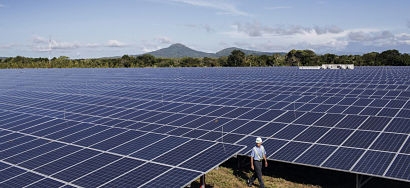 Renewable energy generator Enel Green Power has chosen ABB to install a substation that will deliver solar power from EGP’s solar PV plant at São Gonçalo in Piauí, Brazil, to the country’s 500 kilovolt (kV) transmission network. It is the world’s first digital substation for the 500 kV alternating current rating.
Renewable energy generator Enel Green Power has chosen ABB to install a substation that will deliver solar power from EGP’s solar PV plant at São Gonçalo in Piauí, Brazil, to the country’s 500 kilovolt (kV) transmission network. It is the world’s first digital substation for the 500 kV alternating current rating.
ABB delivered Latin America’s first digital substation in Brazil in 2018. EGP decided to digitalise its assets operations and processes shortly after, having taken note of the ABB installation, the process to be achieved by 2020. The aim is to improve energy efficiency, lower maintenance costs and increase EGP’s deployment of sustainable solutions.
Working closely with EGP, ABB proposed various design and engineering alternatives to find the best and most cost-effective solution meeting the company’s requirements.
When completed, the entire 608 MW plant will be capable of generating more than 1,500 GWh of clean solar power – cutting down 860,000 tons of carbon emissions a year. This will be the biggest solar PV power plant in South America and will strengthen Enel Green Power’s position as a global leader in the green energy sector.
PV power is booming in Brazil. Installed capacity is expected to reach 3,000 MW at the end of this year, up 50 percent from 2018. According to ABSOLAR, the Brazilian PV industry trade association, this equates to $1.3 billion of investment in the country’s economy, translating into 15,000 jobs. Given the situation, today’s grid operators require digital solutions to deal with the increasing amount of intermittent renewable and distributed energy sources being integrated into the grid.
For additional information:
ABB
Enel Green Power (EGP)

Chiriqui solar power plant, Panama. Courtesy of Enel Green Power
ABB delivered Latin America’s first digital substation in Brazil in 2018. EGP decided to digitalise its assets operations and processes shortly after, having taken note of the ABB installation, the process to be achieved by 2020. The aim is to improve energy efficiency, lower maintenance costs and increase EGP’s deployment of sustainable solutions.
Working closely with EGP, ABB proposed various design and engineering alternatives to find the best and most cost-effective solution meeting the company’s requirements.
When completed, the entire 608 MW plant will be capable of generating more than 1,500 GWh of clean solar power – cutting down 860,000 tons of carbon emissions a year. This will be the biggest solar PV power plant in South America and will strengthen Enel Green Power’s position as a global leader in the green energy sector.
PV power is booming in Brazil. Installed capacity is expected to reach 3,000 MW at the end of this year, up 50 percent from 2018. According to ABSOLAR, the Brazilian PV industry trade association, this equates to $1.3 billion of investment in the country’s economy, translating into 15,000 jobs. Given the situation, today’s grid operators require digital solutions to deal with the increasing amount of intermittent renewable and distributed energy sources being integrated into the grid.
For additional information:
ABB
Enel Green Power (EGP)
Asia-Pacific Hydrogen Association (APAC Hydrogen Association) launched in Singapore
The Asia Pacific Hydrogen Association (APAC Hydrogen Association) has been formed in Singapore by several industry executives from the renewable energy sector in Asia, in order to promote the use of hydrogen in the region’s power networks.
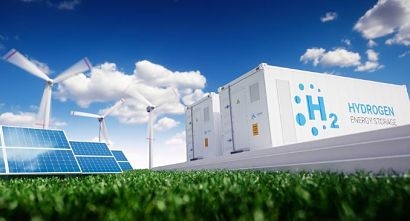 The APAC Hydrogen Association will coordinate international policy, communications, research and analysis and will provide services to support members’ requirements and needs to help their development, offering the best networking and learning opportunities in the sector within AsiaPacific. The association has already received strong support from several leading stakeholders in the hydrogen industry and has welcomed several senior executives on its advisory board.
The APAC Hydrogen Association will coordinate international policy, communications, research and analysis and will provide services to support members’ requirements and needs to help their development, offering the best networking and learning opportunities in the sector within AsiaPacific. The association has already received strong support from several leading stakeholders in the hydrogen industry and has welcomed several senior executives on its advisory board.
“Our mission is to establish and promote the use of hydrogen in the regional economies power as a solution to the region’s rapidly growing energy demand and environmental challenges, providing meaningful benefits to the region as a whole” said Edgare Kerkwijk, one of the founders of the association.
Several activities are being planned in the coming year. In addition to quarterly membership gatherings and industry-specific seminars, the association will organize the first annual Asia Hydrogen Energy Conference during the Singapore International Energy Week in October 2020. This will be the first large-scale regional event for the hydrogen industry.
For additional information:
APAC Hydrogen Association
https://www.renewableenergymagazine.com/

Courtesy of APAC Hydrogen Association
“Our mission is to establish and promote the use of hydrogen in the regional economies power as a solution to the region’s rapidly growing energy demand and environmental challenges, providing meaningful benefits to the region as a whole” said Edgare Kerkwijk, one of the founders of the association.
Several activities are being planned in the coming year. In addition to quarterly membership gatherings and industry-specific seminars, the association will organize the first annual Asia Hydrogen Energy Conference during the Singapore International Energy Week in October 2020. This will be the first large-scale regional event for the hydrogen industry.
For additional information:
APAC Hydrogen Association
https://www.renewableenergymagazine.com/
Chủ Nhật, tháng 2 09, 2020
Đã có cách chế tạo pin năng lượng có thể tạo ra điện vào ban đêm
2:29 CH
No comments
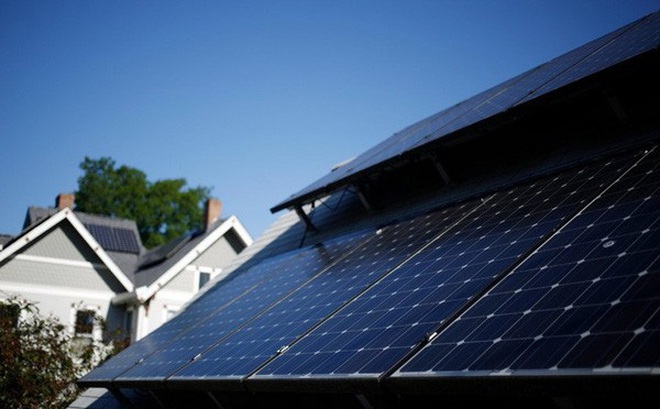
Nhờ ứng dụng nguyên lý hoàn toàn ngược lại với các tấm pin năng lượng Mặt Trời, các nhà khoa học đã tạo ra được những tấm pin có khả năng tạo ra năng lượng vào ban đêm.
Một trong những vấn đề với pin Mặt Trời là chúng không thể tạo ra điện vào ban đêm. Thay vào đó, chúng thường chỉ có thể tích điện đã tạo ra trong suốt cả ngày. Tất nhiên cách vận hành này khá hiệu quả nhưng nếu chúng ta có thể tạo ra các tấm pin có thể tạo ra điện vào ban đêm thì sao? Điều đó hoàn toàn có thể và cách nó hoạt động có thể khiến bạn ngạc nhiên.
Các nhà nghiên cứu tại Đại học California cho biết, nếu bạn muốn tạo ra một tấm pin hoạt động vào ban đêm, bạn sẽ cần phải tạo ra cơ chế vận hành hoàn toàn ngược so với pin Mặt Trời. Nó có thể coi như một tấm pin chống lại ánh sáng Mặt Trời vậy.
Các tấm pin năng lượng Mặt Trời có nhiệt độ thấp hơn nên nó có khả năng hấp thụ ánh sáng Mặt Trời và biến nó thành điện năng. Trong khi đó, không gian ngoài Trái Đất rất lạnh. Do đó nếu bạn có thể hướng tấm pin về phía nó, tấm pin có thể tỏa nhiệt dưới dạng ánh sáng hồng ngoại. Nếu biết cách nắm bắt nguồn nhiệt đó, chúng ta hoàn toàn có thể tạo ra điện năng.
Theo tuyên bố của nhóm nghiên cứu, những tấm pin này có thể tạo ra được khoảng 1/4 lượng điện vào ban đêm mà một tấm pin Mặt Trời bình thường tạo ra vào ban ngày.
Jeremy Munday, giáo sư khoa Kỹ thuật Điện và Máy tính tại Đại học California đồng thời là tác giả nghiên cứu cho biết, tấm pin Mặt Trời hay pin cản ánh sáng Mặt Trời thực chất chỉ là những "động cơ nhiệt".
Munday chia sẻ: "Bạn có năng lượng nhiệt từ Mặt Trời truyền tới Trái Đất và pin năng lượng Mặt Trời sẽ thu lấy năng lượng đó. Vì vậy về cơ bản, bạn cần hai vật thể có nhiệt độ khác nhau và một số cách để chuyển đổi nguồn năng lượng đó. Những gì mà thiết bị này vận hành vào ban đêm cũng tương tự như vậy. Chúng ta cần một cơ thể nóng như Trái Đất và một cơ thể lạnh như không gian vũ trụ. Vì sức nóng lan truyền từ Trái Đất ra ngoài không gian. Do đó chúng ta có thể lấy nguồn nhiệt đó và chuyển đổi nó thành điện năng".
Hệ thống này sử dụng pin bức xạ nhiệt để tạo ra điện, trái ngược với pin quang điện sử dụng trên các tấm pin năng lượng Mặt Trời. Trong đó một tấm pin Mặt Trời thường được làm bằng silicon, vật liệu rất hiệu quả để hấp thụ ánh sáng nằm trong quang phổ có thể nhìn thấy.
Trong khi đó với tấm pin này, nó phải làm từ một vật liệu nào đó giúp thu ánh sáng có bước sóng dài. Hiện tại Munday đang xem xét có nên sử dụng các hợp kim thủy ngân để chế tạo loại pin nhiệt điện này hay không. Nhóm nghiên cứu của Mundy cũng đang phát triển các nguyên mẫu đầu tiên của loại pin hoạt động vào ban đêm.
Đây không phải lần đầu các nhà khoa học nghĩ về một tấm pin có thể hoạt động ngay cả vào ban đêm.
Hồi tháng 11, các nhà khoa học tại Đại học Stanford đã đăng tải một nghiên cứu trên tạp chí Jouele về một loại pin nhiệt điện có thể bức xạ nhiệt ra ngoài không gian để tạo ra điện.
Không giống các loại pin nhiệt điện truyền thống khác, thiết bị của các nhà khoa học kết hợp mặt lạnh của mô-đun nhiệt điện với bề mặt hướng lên trời. Thiết bị sẽ bức xạ nhiệt độ vào không gian lạnh lẽo và lấy nhiệt lượng từ không khí xung quanh, từ đó tạo ra điện năng.
Hệ thống pin năng lượng Mặt Trời đã có những cải tiến mạnh mẽ trong nhiều năm qua để đáp ứng nhu cầu năng lượng. Tuy nhiên nếu chúng ta có thể tạo ra một hệ thống sản xuất năng lượng sạch liên tục 24 giờ/ngày, chúng ta có thể tạo ra đươc nhiều điện năng hơn, đồng thời lưu trữ cho nhiều mục đích khác nhau, đề phòng trường hợp khẩn cấp cần dùng tới.
Nghiên cứu đã được đăng tải trên tạp chí ACS Photonics mới đây.
Tham khảo Inverse
Đừng tưởng điện gió là sạch, cánh tuabin không thể tái chế
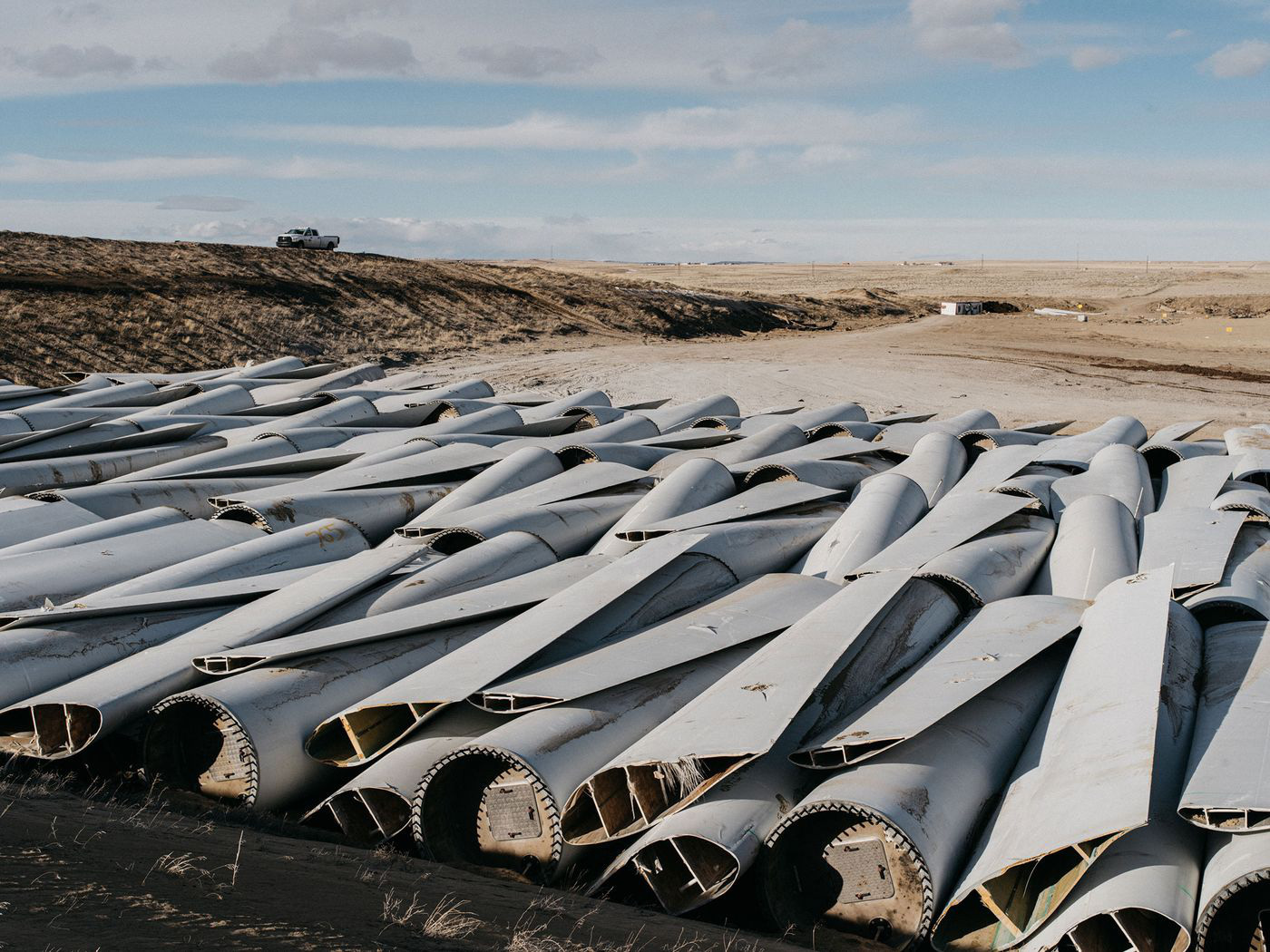
Nếu bạn chưa biết thì mỗi cánh của tuabin gió có thể dài hơn cánh máy bay Boeing 747, vì vậy khi không thể sử dụng được nữa, chúng không thể để nguyên cả cục để kéo đi xử lý. Và bởi có kết cấu đặc biệt với các sợi thủy tinh lissome, người ta phải dùng cưa công nghiệp với mũi nạm kim cương để xẻ nó ra thành ba mảnh nhỏ, đủ để buộc vào xe đầu kéo.
Bãi rác thành phố ở Casper, bang Utah, Mỹ là nơi an nghỉ cuối cùng của 870 cánh tuabin gió, sau những chuỗi ngày chuyển đổi năng lượng tự nhiên thành điện năng. Các mảnh vỡ của chúng trông giống như xương cá voi bị tẩy trắng và xếp san sát nhau.
"Đây là toàn bộ phần của mùa đông năm nay", chuyên gia về kỹ thuật xử lý chất thải Michael Bratvold chia sẻ khi đang xem một chiếc xe ủi chôn chúng xuống cát mãi mãi. "Tôi sẽ nhận phần còn lại khi thời tiết ấm hơn vào mùa xuân này."
Hàng chục ngàn cánh tuabin gió, trông như những lưỡi kiếm già cỗi, được tháo ra từ các tuabin gió khổng lồ trên khắp thế giới, hầu hết không có nơi nào để đi ngoài bãi rác. Chỉ riêng ở Mỹ, khoảng 8.000 cái sẽ bị loại bỏ trong mỗi 4 năm tới. Ở Châu Âu, có khoảng 3.800 chiếc bị hạ xuống hàng năm, cho đến ít nhất là năm 2022. Mọi việc sẽ trở nên tồi tệ hơn vì hầu hết các tuabin gió này được tạo ra cách đây hơn một thập kỷ. Số lượng sẽ tăng lên bởi chúng liên tục được xây dựng trong những năm gần đây và khi tới chu kỳ thay thế đó sẽ là một con số khổng lồ.
Được chế tạo để chịu được gió bão, những "lưỡi kiếm" này không thể dễ dàng bị nghiền nát, tái chế hoặc tái sử dụng. Điều đó khiến chúng bị kỳ thị, thậm chí ở nhiều bãi chứa chất thải. Ở Mỹ, chỉ có một số bãi rác chấp nhận loại rác này, như ở Lake Mills, Iowa, Sioux Falls, South Dakota và Casper, nơi chúng sẽ bị giam trong các ngăn xếp ở độ sâu khoảng 10 mét.
Bob Cappadona, giám đốc điều hành của công ty xử lý chất thải đa quốc gia Veolia Envirnement SA, đang tìm kiếm những cách tốt hơn để xử lý những "lưỡi kiếm" khổng lồ này.
"Hầu hết các bãi chôn lấp được coi là một ngôi mộ khô", ông nói. "Điều cuối cùng chúng tôi muốn làm là tạo ra ít ảnh hưởng tới môi trường hơn nữa."
Để ngăn chặn sự biến đổi khí hậu do đốt nhiên liệu hóa thạch, nhiều chính phủ và tập đoàn đã cam kết chỉ sử dụng năng lượng sạch vào năm 2050. Năng lượng gió là một trong những cách rẻ nhất để đạt được mục tiêu đó.
Điện đến từ các tuabin góp làm quay máy phát điện. Các mô hình tuabin gió hiện đại xuất hiện sau lệnh cấm vận dầu mỏ Ả Rập năm 1973, khi sự thiếu hụt buộc các chính phủ phương Tây phải tìm giải pháp thay thế cho nhiên liệu hóa thạch. Trang trại điện gió đầu tiên ở Mỹ được lắp đặt tại New Hampshire vào năm 1980 và sau đó bang California đã triển khai hàng ngàn tuabin gió ở phía đông San Francisco, khu vực đèo Altamont.
Các mô hình tuabin gió đầu tiên khá đắt tiền và không hiệu quả, quay nhanh và khá thấp. Sau năm 1992, các nhà sản xuất đã đầu tư tạo ra các thiết kế cao hơn và mạnh hơn. Các ống thép của chúng tăng tới 80 mét và cánh được làm bằng sợi thủy tinh siêu bền. Một thập kỷ sau, General Electric đã tạo ra mô hình có công suất 1,5 megawatt, một tuabin gió đủ cung cấp điện năng cho 1.200 căn nhà.
Năng lượng từ gió không có carbon và khoảng 85% các thành phần của tuabin, bao gồm thép, dây đồng, thiết bị điện tử và các linh kiện khác có thể được tái chế hoặc tái sử dụng. Nhưng các cánh tuabin vẫn rất khó xử lý. Một số chiếc có thể dài hàng chục mét, khiến chi phí vận chuyển tăng cao, thậm chí chúng bị cấm vận chuyển ở một số tuyến đường dài. Các nhà khoa học đang cố gắng tìm ra những cách tốt hơn để tách nhựa ra khỏi sợi thủy tinh, hoặc tìm cách tái chế chúng thành những mảnh nhỏ dưới dạng viên hoặc tấm.
Cho đến khi việc tái chế quy mô lớn được phổ biến, các bãi chôn lấp vẫn phải chứa các "lưỡi kiếm" khổng lồ nhưng vô dụng này.
Ở châu Âu, nơi có các quy định chặt chẽ về loại vật liệu có thể mang vào bãi rác, một số cánh tuabin được mang đi đốt trong lò nung để tạo ra xi măng hoặc trong các nhà máy điện. Nhưng hàm lượng năng lượng tạo ra từ chúng khá yếu và không đồng đều, đồng thời sợi thủy tinh cháy phát ra các chất ô nhiễm.
Trong một dự án thí điểm năm ngoái, tập đoàn Veolia đã thử nghiền chúng thành bụi, sau đó tìm kiếm loại hóa chất phù hợp để chiết xuất. "Chúng tôi nghĩ ra một số ý tưởng điên rồ và muốn làm cho việc tái chế nó trở nên bền vững. Có rất nhiều vấn đề cần quan tâm."
Một công ty khởi nghiệp mang tên Global Fiberglass Solutions, đã phát triển một phương pháp để phá vỡ các cánh tuabin và ép chúng thành các viên và tấm, để sử dụng cho vật liệu sàn và tường. Công ty bắt đầu sản xuất các mẫu tại một nhà máy ở Sweetwater, Texas, gần các trang trại điện gió tập trung lớn nhất châu Mỹ. Công ty cũng có kế hoạch khai thác kinh doanh khác ở Iowa.
"Chúng tôi có thể xử lý 99,9% một cánh tuabin và xử lý khoảng 6.000 đến 7.000 chiếc mỗi năm, với mỗi nhà máy. Công ty đã tích lũy được một kho dự trữ cánh tuabin cho khoảng một năm, sẵn sàng để cắt nhỏ và tái chế khi nhu cầu tăng", Giám đốc điều hành Don Lilly cho biết. "Khi chúng tôi bắt đầu bán cho nhiều nhà xây dựng hơn, chúng tôi có thể tiếp nhận nhiều nguyên liệu hơn nữa. Hiện giờ chúng tôi chỉ đang chuẩn bị."
Tuy nhiên cho đến lúc việc kinh doanh nói trên khả thi, các bãi rác đô thị sẽ phải gánh vác trách nhiệm nặng nề này. Bởi theo Hiệp hội Năng lượng gió Hoa Kỳ, đây vẫn là cách xử lý an toàn và rẻ nhất. Ít ra thì hiện tại, nó vẫn chỉ chiếm một phần nhỏ trong lượng rác cần chôn lấp khổng lồ tại Mỹ.
Tại Iowa, Waste Management Inc, đã hợp tác chặt chẽ với các công ty năng lượng tái tạo để đưa ra giải pháp xử lý, tái chế và xử lý các cánh quạt của tuabin gió. Công ty có khoảng 10 xe tải lớn để thu gom chúng mỗi ngày, tại bãi rác Lake Mills.
Quay trở lại bang Utah, dưới bóng một ngọn núi phủ tuyết, Casper vẫn là nơi phù hợp để các chứa rác từ các trang trại điện gió. Thành phố này nhận được 675.000 mỗi năm tiền đền bù, để chứa các cánh quạt tuabin gió vô thời hạn. Số tiền được dùng để cải thiện sân chơi và các dịch vụ khác của người dân. Theo người quản lý bãi rác thành phố, Cynthia Langston, thì ít ra các cánh tuabin này vẫn sạch hơn nhiều so với các thiết bị máy móc cũ hỏng khác.
Tuy nhiên, những người nhân công làm việc ở bãi rác cũng không thoải mái gì lắm với thứ phế liệu khổng lồ này. Bởi chúng quá lớn và bền, họ đã phải tìm mọi cách để ép chúng với nhau cho bớt chiếm diện tích. Họ đã thử mọi thứ, từ máy ủi, máy xúc cho tới các thiết bị chuyên dụng, nhưng thứ để lại chỉ là các vệt hằn nhẹ trên thân cánh tuabin. Và có ít thời gian để lãng phí vì mùa xuân đang đến, đi kèm với nó là cuộc diễu hành vô hồn của những mảnh cánh tuabin gió sắp được chở tới.
Tham khảo bloomberg
UK-German alliance in solar digital drone inspections

UK aerial inspection and data analytics company Above has acquired German drone start-up Ucair.
The buy means Above (formerly Above Surveying) has broken into the German market and it says it will also strengthen its presence in other European countries.
Above has been a pioneer of combining drone-based inspections of solar plant with cutting-edge data solutions.
“Digitalisation and automation of solar inspections will play a fundamental role in the increasing deployment of utility scale-solar” said Will Hitchcock, founder and chief executive of Above.
He said that “it is now well established that thermography provided by drones is the most efficient way of analysing the health of large-scale solar assets”.
He added that Ucair and Above “have been anticipating the digital transformation needed in the solar industry and have both invested heavily into the automation of their analysis process – but more importantly – into digitalisation and data mining”.
“Above is strongly positioned to scale its reach across the globe and accelerate its ambition to be the leading aerial inspection and data analytics company thanks to its advances in
the automation of aerial inspections,” he said. “Together we will draw on our market knowledge to strengthen our service offering and software capabilities.”
Above and Ucair have already collaborated over the past two years in a bid to improve best practices in the sector and ucair chief executive Viola Hoffmann said “this has made the union of the two companies a logical next step”.
How Renewable Energy Can Help Improve Health
How Renewable Energy Can Help Improve Health
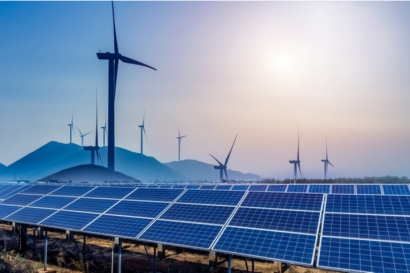
Viable energy technologies utilize properties right from the environment to bring about power. These energy sources comprise wind, sunlight, waves etc. As the most popular sources of renewable energy, they won’t dry up, whereas fossil fuels are always likely to run out. Quite normally, they will be highly difficult to obtain, thereby disturbing both the economical as well as environmental cycle.
A number of studies have been conducted and it’s revealed that renewable energy technologies entail less maintenance than dynamos that involve conventional fuel sources. The reason is quite simple though. It is because technology like wind transformers and solar panels either have few or no stirring parts. Also, they don’t bank on combustible fuel sources to set off. Less maintenance requirements mean users save considerable amounts of time and money.
Yes, using sustainable energy can help you save money down the line. Along with the maintenance costs, you would start saving on operating costs too. Naturally, when you are taking recourse to a technology that engenders power from natural sources like steam, wind, and the sun, you no longer have to think about refueling.
The amount of money you will save using viable or sustainable energy can differ based on different factors, and it counts on the technology too. In most cases, switching to renewable energy means anywhere from hundreds to thousands of pounds or dollars in savings. Sunlight is ample and abundant. The same goes for wind. Wind generators can convert the energy into electricity with nominal impact on environment. Moreover, sustainable energy formation doesn’t entail purchasing and selling the very energy sources. Heat deriving from winds, streaming water, and sunlight promises to dole out a steady and cost-efficient energy supply for many years to come.
The fact that renewable sources technologies produce little to almost no greenhouse gases leads toward less air pollutants into the air. This smaller carbon footprint, quite naturally, paves the way for a complete positive impact on the environment. During the ignition process, fossil fuels tend to emanate high volume of carbon dioxide gas, which has been proven to aggravate the escalation of global temperatures and incidence of intense weather events. Apart from the greenhouse gases, the damaging pollutants released in due course of burning fossil fuels lead toward several cardiac as well as respiratory issues. With the use of sustainable energy, you would certainly cut down the presence of these contaminants, and account for an overall healthier atmosphere.
By contributing to less greenhouse releases, we can play an active role in alleviating the greenhouse effect and perk up air quality, thereby creating a better world to live in. Nitrous oxide, Carbon dioxide, and sulfur dioxide unleashed by fossils fuels can be dangerous or deadly to human health, if inhaled for long. Cleaner air, on the other hand, would certainly help to save lives, especially when it involves respiratory conditions and even cancers. With viable energy technologies, you can crop up energy locally. The more sustainable energy you’re using for your power backups, the less you have got to depend on shipped in energy means.
According to Allied Market Research, the global renewable energy market is expected to grow at a significant CAGR from 2018–2025. Limited use of fossil fuel along with its volatile prices drive the growth of the market. On the other hand, high manufacturing cost is anticipated to hinder the growth to some extent. However, rise in the number of electric vehicles has almost modulated the factor and paved the way for a gamut of new opportunities in the industry.
Rapid advancements in high-end technologies and increase in government initiatives to support renewables have proved to be highly beneficial for the market. To sum up, it can be stated that the renewable energy market size is swelling up on a sturdy note, and strict government norms to combat climate change in the developed and developing economies are projected to boost the market growth yet more in the next few years.
Source : https://www.renewableenergymagazine.com/
Thứ Bảy, tháng 2 08, 2020
Nấm ăn bức xạ được tìm thấy trong lò phản ứng hạt nhân Chernobyl
Một loại nấm đen có thể ăn bức xạ đã được phát hiện bên trong lò phản ứng hạt nhân Chernobyl khiến giới khoa học bất ngờ.
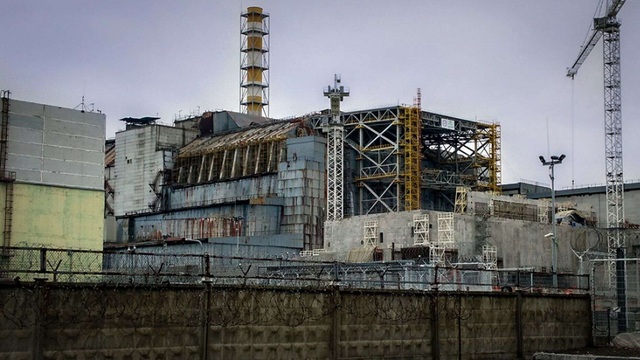
Nhấn để phóng to ảnh
Năm 1991, loại nấm kỳ lạ đã được tìm thấy mọc lên trên các bức tường của lò phản ứng, khiến các nhà khoa học gặp nhiều khó khăn trong việc đi tìm lời giải do môi trường khắc nghiệt, nặng bức xạ như vậy.
Các nhà nghiên cứu cuối cùng nhận ra rằng thực tế dường như bực xạ nguy hiểm lại là nguồn thu hút nấm.
Một thập kỷ sau, các nhà nghiên cứu đã thử nghiệm một số loại nấm và xác định rằng nó có một lượng lớn sắc tố melanin cũng được tìm thấy, trong số những nơi khác như trên da của con người.
Những người có tông màu da tối hơn có xu hướng có nhiều melanin, được biết là hấp thụ ánh sáng và làm tiêu tan bức xạ tia cực tím trong da.
Tuy nhiên, trong nấm nó đã hấp thụ bức xạ và chuyển đổi thành một số loại năng lượng hóa học để phát triển.
Trong một bài báo năm 2008, Ekaterina Dadachova – nhà nghiên cứu thuộc Đại học Y Albert Einstein ở New York, đã lưu ý rằng loại nấm thu hút bởi bức xạ dường như không phải là ví dụ đầu tiên của loại này.
"Một lượng lớn bào tử nấm đã được tìm thấy trong các mỏ đá thời kỳ kỷ Phấn trắng đầu tiên khi nhiều loài động vật và thực vật chết”, Ekaterina Dadachova nói.
Thông tin này khiến các nhà khoa học nghĩ tới một giả thuyết đó là nấm có thể có những nơi xa xôi trong vũ trụ nơi sinh vật có thể sống trong môi trường đầy bức xạ.
Minh Long(TheoDantri)
Theo Fox News
Đăng ký:
Nhận xét (Atom)



